There was once a murder in a hotel in St. Louis where the cops proved the husband drowned the wife in the bath tub because, they claimed, women never take baths in hotels. Now, I am not advocating for a free pass should Chris tire of my whining and hold me below sea level. However, I am a hotel bath taker, provided the tub is adequate. And I’m pleased to report that the tub at the Marmara Pera, while a tad short, is plenty deep. In case you were wondering.
In addition to the stellar tub action, I should note that the hotel also has the best breakfast buffet I’ve ever seen. In addition to hot dishes like tiny, fat Turkish sausages, scrambled eggs and breakfast potatoes, there was a whole spread offering everything from tomato chunks to grapefruit wedges to cereal. Large white bowls brimmed with olives, fruit salad and yogurt, while fresh honey still on the comb awaited scraping. An omelet station let you pick your own ingredients while another table offered up a wide variety of breads and sweet pastries. There were plates with a variety of Turkish cheeses, and sliced cold cuts, a variety of cereals and granola, as well as three or four different juices, all freshly squeezed. And the whole thing doesn’t end until the very civilized hour of 10:30. Nice.
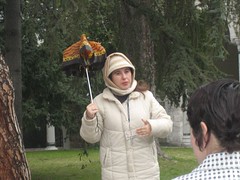 Once we were all stuffed, we met up with Melike – our tour guide, translator and general savaior for the week – in the hotel lobby. In addition, we were joined by another tour guide, Lala (pronounced la-LAY), who would spend the bulk of the day herding us around various sites. As we rode in the bus to the first stop on our day of sight-seeing, the sky was already grey and threatening to drizzle, a drastic change from the day before. That said, it was still a lot warmer than we had anticipated – 50 degrees F or so, compared to our anticipated 30-40.
Once we were all stuffed, we met up with Melike – our tour guide, translator and general savaior for the week – in the hotel lobby. In addition, we were joined by another tour guide, Lala (pronounced la-LAY), who would spend the bulk of the day herding us around various sites. As we rode in the bus to the first stop on our day of sight-seeing, the sky was already grey and threatening to drizzle, a drastic change from the day before. That said, it was still a lot warmer than we had anticipated – 50 degrees F or so, compared to our anticipated 30-40.
Lala shared with us a number of facts about Turkey as the bus driver expertly navigated some of the tight turns through Istanbul’s compact cobblestone streets. We learned that although the region dates back to Byzantium, Turkey is a relatively young republic, founded in 1923 in the area formerly known as Constantinople. The name Istanbul is a derivative of the word “stanpoli” which means, literally, “toward the city.” And there are around 6,000 mosques in the city. So now you know.
I’ve never seen a city that looks quite like Istanbul – jam-packed with pastel-colored buildings in various states of disrepair and assembled seemingly without plan accented by majestic mosques. Despite the cars and the modern ways, it’s impossible to ignore its link to a past so lengthy I can barely imagine it. We passed so many notable areas, I can’t remember most of them, although I do remember Lala pointing out the end point of the original Orient Express train. It’s now a crumbling, abandoned train station.
 We soon arrived at our first destination in Sultanahmet, Topkapi Palace, the first residence of Ottoman Sultans from 1453-1856. Before we got off the bus to forget our “American courtesy” – a term which strikes me as an oxymoron – and be sure to ignore the many folk who will try to stop and sell us things as we make our way from one tourist spot to another. Eye contact, a glance, the merest hint of hesitation and they will attach themselves to you, working the chance, hoping to wear you down as they match your steps block for block. She told us it would seem cruel to us, but the only way to get away from them is to ignore them and keep moving.
We soon arrived at our first destination in Sultanahmet, Topkapi Palace, the first residence of Ottoman Sultans from 1453-1856. Before we got off the bus to forget our “American courtesy” – a term which strikes me as an oxymoron – and be sure to ignore the many folk who will try to stop and sell us things as we make our way from one tourist spot to another. Eye contact, a glance, the merest hint of hesitation and they will attach themselves to you, working the chance, hoping to wear you down as they match your steps block for block. She told us it would seem cruel to us, but the only way to get away from them is to ignore them and keep moving.
Only the elements of weather and time conspired to make it a less than perfect day. We had only an hour or so to wander about the vast grounds of Topkapi, barely time to make a dent, in fact. The grand palace comprises four courts, each of which offered admittance only to certain groups of people. We got to briefly explore a few of them, including the former kitchens, which now hold displays featuring everything from period clothing to ceramics to gemstones to hairs or Mohammed and the arm of John the Baptist.
It’s a shame we were so rushed because it felt like there wasn’t real time to see everything and let it sink in. And we didn’t have time to check out The Harem, which is frequently billed as the most interesting part of the trip. It’s possible I’ll come back and check it out later in the week, although the lines are said to be quite long unless you get there early in the day.
As we left to make our way to the Aya Sophia and the Blue Mosque, the rain had started pouring down and we were damp and cold, kicking off a week of sickness for some folk. A few were wet enough not to ignore the wares of street vendors hawking umbrellas – including, of course, Tony, who is friendly to everyone.
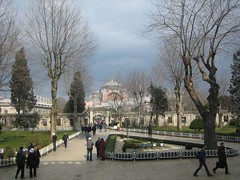 The dark, cavernous interior of Aya Sophia didn’t exactly warm us up, either. Although I’ve seen the place in photos at sunset or in full sunshine, even its pale pink exterior didn’t brighten the skyline. Often known by its Greek name, Hagia Sophia, it’s an interesting place that has been, in its time, a church, a mosque and now a museum. It was originally built as the Church of the Apostles in 360 AD, although rough times required rebuilding the structure in the year 532 when the city was known as Novo Roma.
The dark, cavernous interior of Aya Sophia didn’t exactly warm us up, either. Although I’ve seen the place in photos at sunset or in full sunshine, even its pale pink exterior didn’t brighten the skyline. Often known by its Greek name, Hagia Sophia, it’s an interesting place that has been, in its time, a church, a mosque and now a museum. It was originally built as the Church of the Apostles in 360 AD, although rough times required rebuilding the structure in the year 532 when the city was known as Novo Roma.
The interior is vast, with a giant domed ceiling. In fact, it’s the fourth biggest cathedral in the world – not too shabby considering that the other three (St. Paul in London, St. Peter in Rome and the Duomo in Milan) were all built at least 1,000 years afterwards. And, perhaps most amazingly, the Aya Sophia was completed in an unthinkable five years with the involvement of tens of thousands of workers.
When we visited, the dimly lit interior was overwhelmed by a giant shaft of scaffolding that is, according to Lala, practically a permanent fixture. The domes and walls of the museum are constantly undergoing renovation and restoration, whenever funds are available to allow it. At the base of the scaffolding, behind protective barriers, lay the enormous chandelier that used to hang from the center of the dome, like an abandoned giant metal skeleton.
It’s fascinating – and extremely rare, of course – to be in a place where a mural of Mary and Jesus towers over us, right next to giant calligraphic circles containing the symbols for Allah and Muhammed. Also interesting is the altar, which appears askew on the wall because the building was built as a church and when it was converted to a mosque, the altar had to face Mecca, regardless of whether that meant it was centered on the wall. No one’s worshipped here for quite a while, although a little orange cat was curled up right against one of the footlights illuminating the altar and I’m sure his gratitude for the warmth was quite spiritual. Time was running out, so we had to leave before getting a glimpse at the Byzantine mosaics in the upper balconies, which was terribly disappointing.
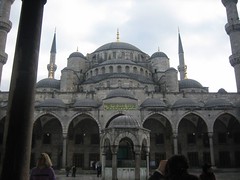 We skipped the Archaeological Museum and went straight to the Basilica Cisterns. Built for the Byzantium Palace it’s an amazing, giant underground world built by the Greeks in the 6th century, using columns and stones they’d scavenged from elsewhere. (The cisterns apparently provided water to the various fountains and pipes above ground.) Now, wooden walkways let you wander through this other-worldly, dimly lit fantasy land where a foot or so of water serves as home to a number of lazy, slow-moving fish. It’s hard to explain the appeal of it, because it sounds a little odd – and photos don’t really do it justice – but it’s something to experience. (Trivia tidbit: apparently the cistern was used for a scene in the James Bond flick, To Russia with Love.)
We skipped the Archaeological Museum and went straight to the Basilica Cisterns. Built for the Byzantium Palace it’s an amazing, giant underground world built by the Greeks in the 6th century, using columns and stones they’d scavenged from elsewhere. (The cisterns apparently provided water to the various fountains and pipes above ground.) Now, wooden walkways let you wander through this other-worldly, dimly lit fantasy land where a foot or so of water serves as home to a number of lazy, slow-moving fish. It’s hard to explain the appeal of it, because it sounds a little odd – and photos don’t really do it justice – but it’s something to experience. (Trivia tidbit: apparently the cistern was used for a scene in the James Bond flick, To Russia with Love.)
After, it was on to the so-called Blue Mosque, which locals call the Sultanahmet Camii. It is not blue on the outside, but its interior walls are decorated by blue iznik tiles. To say it’s a pretty big deal is both understatement and accurate. For some reason, I didn’t expect it to be currently in use but as Lala led us inside, a handful of Muslims were quietly worshipping. (We took our shoes off before entering to keep the carpet on which people pray clean.)
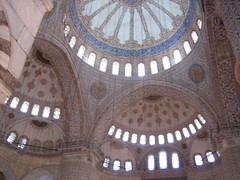 Inside, Lala escorted us to a back area where we sat while she told us a little bit about Islam. I must admit that I don’t know a lot about the religion, including the differences between the various branches. According to Lala, there are five basic pillars of Islam , which she delivered (I believe) in no particular order. First, she said, one must pray five times a day and when you do it, you have to do it from the heart. In Islam, prayer is a silent, individual pursuit. Second, healthy adult Muslims fast from sunrise to sunset during Ramadan. The idea, apparently, is to demonstrate the ability to control oneself while simultaneously preparing for survival during hard times that could lie ahead.
Inside, Lala escorted us to a back area where we sat while she told us a little bit about Islam. I must admit that I don’t know a lot about the religion, including the differences between the various branches. According to Lala, there are five basic pillars of Islam , which she delivered (I believe) in no particular order. First, she said, one must pray five times a day and when you do it, you have to do it from the heart. In Islam, prayer is a silent, individual pursuit. Second, healthy adult Muslims fast from sunrise to sunset during Ramadan. The idea, apparently, is to demonstrate the ability to control oneself while simultaneously preparing for survival during hard times that could lie ahead.
Third, Muslims must make a trip to Mecca, or Hajj, in their lifetime, if they can afford to do so. Fourth, Islam asks its followers to help those less fortunate by giving, in some form, 10% of their annual income. And five, Muslims believe there is only one god, Allah, and that Mohammad was one of his prophets. Clover seemed to think, based on his vast experience in the Middle East, that jihad was also a requirement of Islam, although Lala disagreed. (We did get the distinct feeling we were getting a very specific explanation of the religion, which may not have covered all branches.)
I should also take a moment here to note that although we, as Westerners, react strongly just to hearing the word “jihad,” it actually has a wide range of meanings within the Muslim world. While it can mean the sort of violent uprising or holy war we often assume, it can also refer to a deep inner spiritual struggle for perfection in faith as well. At the least, I’m feeling humbled and slightly embarrassed about how little I really know of Islam. Fortunately, it looks like we’ll have several opportunities to rectify that in the week to come.
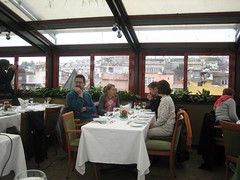 Our sightseeing ended for the morning, we went off for a lunch ‘n lecture at the Hotel Armada. The restaurant there is a rooftop spectacular, with a wall of windows on one side overlooking the Marmara Sea and the Blue Mosque and Aya Sophia on the other side. For lunch, we enjoyed a salad of something I couldn’t quite discern, followed by what turned out to be pureed eggplant with béchamel sauce topped with chunks of lamb in a slightly sweet, tomato-y sauce. Dessert was, depending on who you asked, either yams or pumpkin in honey. Trying to avoid sugar, I skipped the latter but enjoyed a cup of strong coffee with milk.
Our sightseeing ended for the morning, we went off for a lunch ‘n lecture at the Hotel Armada. The restaurant there is a rooftop spectacular, with a wall of windows on one side overlooking the Marmara Sea and the Blue Mosque and Aya Sophia on the other side. For lunch, we enjoyed a salad of something I couldn’t quite discern, followed by what turned out to be pureed eggplant with béchamel sauce topped with chunks of lamb in a slightly sweet, tomato-y sauce. Dessert was, depending on who you asked, either yams or pumpkin in honey. Trying to avoid sugar, I skipped the latter but enjoyed a cup of strong coffee with milk.
Lunch was followed by a talk on the Ottoman Empire by Professor Hakan Erdem, a novelist and teacher at Sabanci University in Istanbul. It was definitely a thorough talk and if I failed to absorb all the details about Turkey’s rich history, it was due far more to jet lag than to any lack of passion on Erdem’s part. Or the fact that once we were inside, the grey skies turned to impossibly blue with a rich sunshine that sparkled across the surface of the Marmara.
Not that I spent any time staring out the window or anything, but I must say, if I had, I would have been struck by the site of Aya Sophia, perfectly intact, surrounded by “modern” buildings in various states of disrepair – entire walls crumbling, tin roofs rusting, windows missing and paint peeling. I think it says something for the way they used to do things, back when durability and survival were more important than bottom line construction costs.
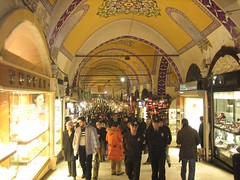 After lunch, we were thrilled to be given a couple of hours of free time at the infamous Grand Bazaar or Kapali Carsi, as the locals call it. While I’d heard much about this place beforehand, it was still quite overwhelming. For centuries, the indoor market has been the place to go for everything from carpets to clothing to jewelry. Now, there are more than 4,000 stores in sub-divided specialty areas (including silver, gold, copper, clothing, carpets, pottery, spices, ceramics, etc.) catering mostly to tourists. That means inflated prices – which you have to be willing to bargain down – and a constant, aggressive appeal to buy from every stand you pass.
After lunch, we were thrilled to be given a couple of hours of free time at the infamous Grand Bazaar or Kapali Carsi, as the locals call it. While I’d heard much about this place beforehand, it was still quite overwhelming. For centuries, the indoor market has been the place to go for everything from carpets to clothing to jewelry. Now, there are more than 4,000 stores in sub-divided specialty areas (including silver, gold, copper, clothing, carpets, pottery, spices, ceramics, etc.) catering mostly to tourists. That means inflated prices – which you have to be willing to bargain down – and a constant, aggressive appeal to buy from every stand you pass.
Since we weren’t in the market for anything in particular, Chris, Gail and I just sort of wandered around some of the packed, smoky “streets.” Unfortunately, it’s hard just to browse since stopping to look at anything constitutes interest and leaves you open to sales tactics that stop just short of bullying. In fact, the pressure to buy became so overwhelming that, after about an hour or avoiding eye contact and thus being practically unable to really check anything out, we slipped into one of the cafes and had a quiet drink – joined shortly by Chuck and Lisa, also seeking refuge from the relentless commercialism – until it was time to meet up with the group. For the record, Gail and I ranked “I am your destiny” and “I need your money” as our two favorite sales pitches of the afternoon.
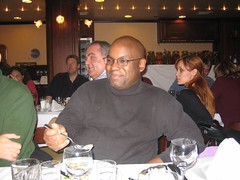 From the bazaar it was on to a dinner listed on our itineraries as “Eating Like A Turk,” hosted by famed Turkish “gurme” Engin Akin at a restaurant called Hunkar, which aims to preserve Ottoman Empire recipes. It was a multi-course feast with small portions of 20 or so Turkish dishes ranging from lentil and fava bean appetizers to poof bread, meatballs shaped like “ladies thighs” and dolma to mante, an exquisite meat and onion ravioli in a yogurt sauce. (We were also treated again to the Sultan’s favorite, the béchamel eggplant and lamb stew we had at lunch.)
From the bazaar it was on to a dinner listed on our itineraries as “Eating Like A Turk,” hosted by famed Turkish “gurme” Engin Akin at a restaurant called Hunkar, which aims to preserve Ottoman Empire recipes. It was a multi-course feast with small portions of 20 or so Turkish dishes ranging from lentil and fava bean appetizers to poof bread, meatballs shaped like “ladies thighs” and dolma to mante, an exquisite meat and onion ravioli in a yogurt sauce. (We were also treated again to the Sultan’s favorite, the béchamel eggplant and lamb stew we had at lunch.)
We learned that traditional Turkish meals include white rice served to signify the end. Akin said, “In Turkey, we have a saying – the meal is not truly complete until the chef himself or, maybe, herself is cooked with the meal.” Yeah, I’m not entirely sure what that means, either, but it was followed up with the chef coming out for a bow and all of us giving him a well-deserved KWF-style “thunderous round.”


















